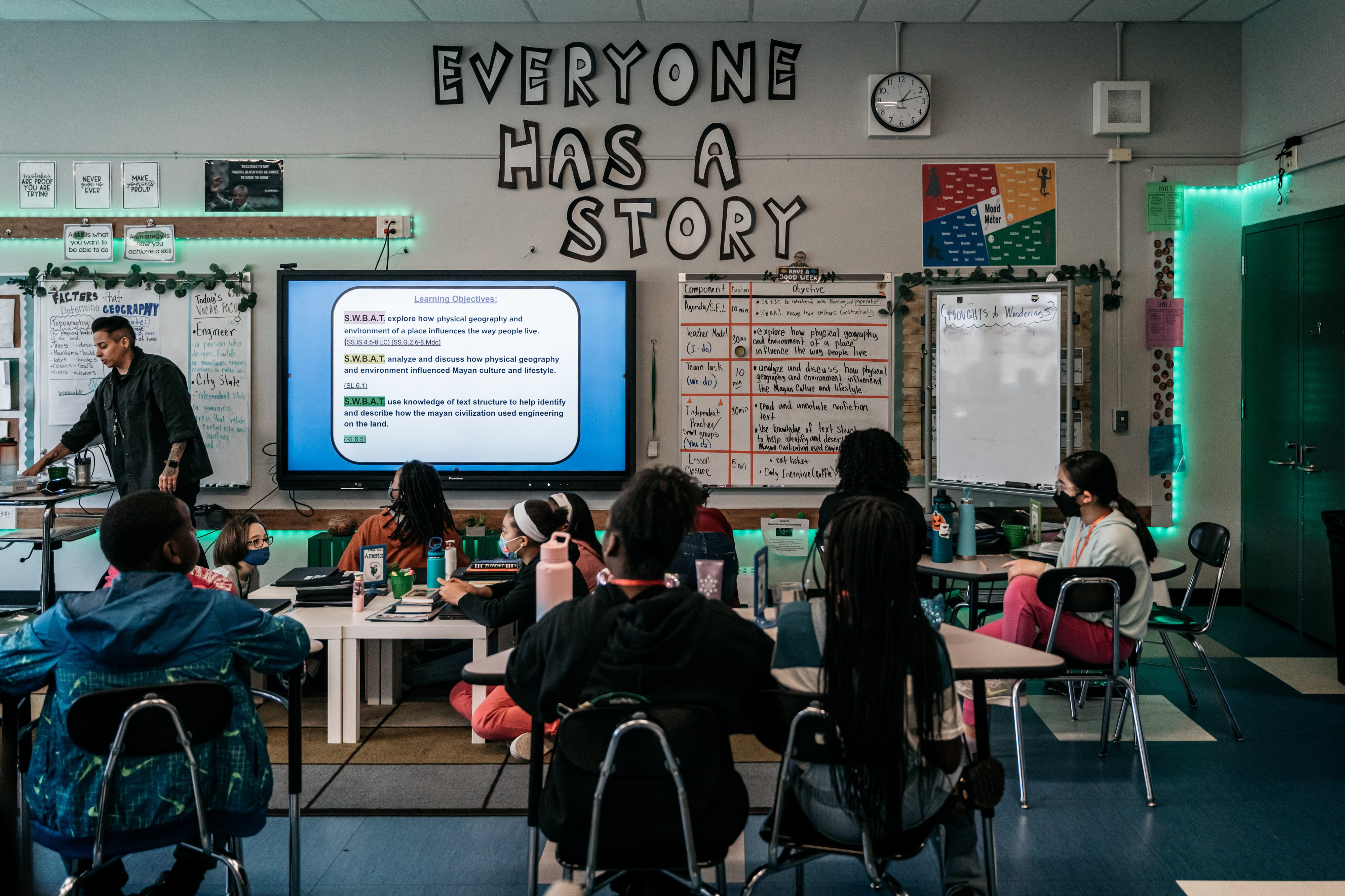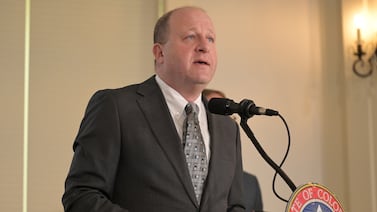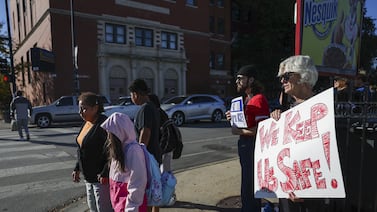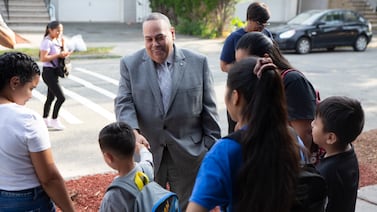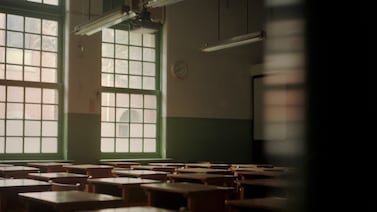Sign up for Chalkbeat Chicago’s free daily newsletter to keep up with the latest education news.
Christina Cedeño has spent countless hours helping get the word out about the bilingual gifted program at her children’s school Pulaski International School of Chicago, texting friends and acquaintances and distributing flyers at neighborhood businesses and day cares in Spanish-speaking neighborhoods.
But next year, Pulaski’s proposed budget cuts a number of positions, including including a core classroom teacher in the Spanish gifted program, forcing school leaders to consider combining the first and second grade.
Cedeño worries the cuts at the Regional Gifted Center for English Learners — one of just three in Chicago Public Schools — will deter parents who are new to the school.
“If they find out that their classes are going to be combined, they’ll get scared and they’ll pull their kids out and then we’re back to where we were five years ago,” she said.
Pulaski is one of many schools reportedly losing resources as Chicago Public Schools officials overhaul the way they allocate money to individual campuses even as they also work to close a $391 million deficit and grapple with the end of federal COVID relief funding.
District officials have said the overall amount of money dedicated to schools is not being decreased. But many selective enrollment and magnet programs and neighborhood schools in higher income areas are seeing cuts. In some cases, district officials have even suggested they fundraise to fill gaps, parents say, which could create more inequity for schools that can’t raise a lot of money.
CPS CEO Pedro Martinez has defended the changes to how schools are funded as an “important milestone” aimed at improving education across all schools, but especially for children “farthest from opportunity.”
“It’s a boost for communities that have been stuck in a downward spiral of disinvestment and depopulation,” he told the school board Thursday.
He added that some school leaders at high-need schools have cheered their budgets for allowing them to grow programming and dodge enrollment-related cuts. And he vowed overall funding for schools will stay stable next fall and, thanks to positions covered centrally, more people will work in Chicago’s schools.
But the public does not have the ability to see which schools are benefiting from the new formula.
CPS has twice denied Chalkbeat’s open records request for individual school budget documents, arguing the process is still ongoing. Local School Councils had to vote to approve their budgets by May 3. A district spokesperson said five elementary schools and four high schools rejected their school budgets.
Last year, the district similarly shared only limited details about school budgets when principals received them in April. Officials unveiled a $9.4 billion budget proposal in early June and the school board approved it two weeks later. The school board must approve a budget by July 1.
Meanwhile, Illinois lawmakers are considering a bill that could prevent Chicago Public Schools from implementing “disproportionate” budget decreases at selective enrollment schools and could place a moratorium on school closings until 2027.
Pulaski is in a unique situation because it’s a neighborhood school with a selective program. For budgeting purposes, it is considered one school and the neighborhood school is also facing cuts, according to parents who spoke to Chalkbeat.
The neighborhood school, which has an International Baccalaureate program, serves students from the surrounding Bucktown area, which has gentrified in the last decade. Ten years ago, 81% of Pulaski’s students came from low-income families and today about 38% do.
Parents said the proposed budget, which was rejected by the Local School Council, would cut three core classroom teachers from the neighborhood program, two specialty teacher positions, a tech coordinator, a reading specialist, and one of two clerks that staff the school’s two-building campus.
“We’re not asking for bells and whistles,” said Nicole Wood, a Pulaski parent who has two children in the neighborhood IB program. “We understand that some of our extras that we had in the past are going to go away. We understand that there will be cuts given the deficit in the budget. However, what we expect CPS to provide us are classroom teachers for all of our classrooms.”
‘If you don’t like your budget, fundraise your way out of it’
At Harriet Tubman Elementary School, parents raised concerns to their CPS network officials when they found out that the proposed budget could mean losing three core teachers and other staff next year.
The surprising suggestion: Fundraise money to fill in the gaps.
Other schools, network officials tell them, use “Friends of” money to pay for positions, said Illeana Inserni, the chair of Tubman’s Local School Council and a mother of third-grade twins.
The school, which has an International Baccalaureate program that draws in students from other parts of the city, is also slated to lose a part-time teacher who works with students with disabilities and their interventionist, a staffer who works with struggling students, whose salary was covered by the district through federal COVID dollars.
Tubman sits in a higher-income area of Chicago and 35% of students come from low-income families, less than the 73% at schools districtwide. But the school’s enrollment has also swelled by about 15% since September and is serving more English learners, according to preliminary enrollment records.
“What we’re asking the network and district … is to maintain our current roster,” Inserni said. “We’re not even asking for more at this moment.”
The school received $140,000 in discretionary funding, which is the minimum amount provided to all elementary schools. Inserni said they plan to pay for another core classroom teacher, leaving the school with about $30,000 for basic operations, materials, and supplies, such as copy paper or recess monitors. The district said the average budget for a teacher position is $123,000.
At Skinner North, a selective enrollment elementary school, according to LSC chair Danielle Capilla, whose daughter is in fifth grade, network leads have also suggested parent fundraising to fill budget gaps.
“Principals are also being asked by network leaders and the folks above them, ‘Well, how much does your ‘Friends Of’ raise? How much is in those bank accounts? What can we use that for?’ Essentially, what can the parents and community pay for so the district doesn’t have to?” Capilla said.
“There has also just been an underlying premise of: ‘If you don’t like your budget, fundraise your way out of it,’” she said.
A district spokesperson said decisions made with parent fundraising resources are made at the school level.
In Chicago, parents can fundraise to pay for staff, which isn’t the case for all big cities. In New York City, PTAs cannot use funding to pay for core subject teachers but can use it toward supplemental staff, such as art teachers or teaching assistants.
Capilla, who also has a son enrolled in a different magnet school, said she doesn’t want to alienate families that can’t afford to contribute to fundraisers. “That would be the last thing that we would want to do.”
She’s heard of other schools, like LaSalle Language Academy in Old Town, using outside fundraising to fill gaps. At LaSalle, LSC parent representative Jason Emeott said next year’s budget does not provide funding for seven of their eight language teachers. But the language program is core to the school’s identity, he noted, with students in kindergarten through eighth grade able to take classes in Spanish, Italian, French, and Mandarin.
Emeott is passionate about LaSalle because it is a National Blue Ribbon School that serves students from around the city of different ethnicities and socioeconomic backgrounds. Now, he worries programming cuts could hurt future enrollment.
At Thursday’s school board meeting, some parents voiced concerns about their school budgets to board members.
Several parents from Sabin Dual Language Magnet said its proposed budget will erode its ability to provide the language services that have made the campus a model as one of the oldest dual language programs in the city. They said the school is losing three teachers and its dean of students, who has gotten recognition for presiding over the largest decrease in student suspensions of any district elementary school.
Parents said the budget apparently fails to account for a large influx of migrant students to the campus, which has helped push enrollment from 240 to more than 360 students since last summer.
“By losing these teachers, we are losing our dual language capacity,” said parent Debra Gittler.
“With so many new arrivals, the trauma and the issues going on are quite severe,” she added.
Are neighborhood schools getting more resources?
Not all schools are seeing cuts. Although all school budgets are not public yet, many neighborhood schools are gaining multiple new staff positions and additional resources.
Under the proposed budget, Jamieson Elementary, a neighborhood school in West Ridge, would add a second school counselor, a restorative justice coordinator, another art teacher, and an additional core teacher that the LSC hopes to hire as an English as a Second Language teacher, according to Annette Stenner, a parent representative on the LSC.
Stenner said the additional positions will be helpful as the school’s needs have increased. Jamieson serves over 800 students and almost 60% of students come from low-income families, according to Chicago Public Schools enrollment data. Over the last couple of years, the school has seen an uptick in the number of migrant students, many migrating from Venezuela and other countries around the globe, Stenner noted.
Many migrant students have “a lot of trauma,” she said. “Teachers and our administrators, they’re seeing a lot more issues addressing that and dealing with that in the classroom.”
While the increase in staff would be helpful to the school, Stenner’s not sure if it will be enough since classroom sizes are large. But overall, she feels that the district is going in the right direction with budgeting to address some of the inequities in funding neighborhood schools across the city.
One principal said her school, which almost exclusively serves students from low-income families and more than half who are learning English as a new language, will see more teachers and some smaller class sizes next school year.
However, the school will not have the funding for their second office clerk – someone the school had for many years who helped with attendance and purchasing, said the principal, who asked to remain anonymous because she was not authorized to speak to the press. While she doesn’t believe student-based budgeting worked well, she said she had become accustomed to having a lot of power over her budget – and cutting the longtime school clerk is a “hard decision.”
But “in what world could I argue that I would rather have 33 first graders in a room together than not have this second clerk?” the principal asked.
Abigail Vences is on the Local School Council at Swift Elementary School in Edgewater and Mather High School in West Ridge. She said next year’s budgets at both schools will see more resources, including several more teacher positions.
“There are kids that want to excel academically and you should let them go for that challenge, but at the same time, you shouldn’t let your neighborhood schools fail,” Vences said.
New funding formula stabilizes shrinking schools
When Mayor Brandon Johnson’s administration announced the new school funding formula in late March, they said it would be more equitable and boost neighborhood schools in disinvested communities where enrollment has been declining for years.
That’s been the case at Hirsch Metropolitan High School in Chatham for the past decade.
Maria Owens has served on the Local School Council since 2014. She said, in the past, Hirsch’s budget did not provide enough to staff all the courses required for graduation so the school had to get creative with online classes and partnerships with nearby schools. Now, they’ll have the basics covered, Owens said.
“We’re not gonna look a gift horse in the mouth, but it’s really not sufficient to do what it is we really need to have done,” Owens said. “If you’re trying to give your child the best possible options, it’s not going to be sufficient for most parents who want to see their child excel.”
Like most schools, about 7% of Hirsch’s budget the past few years was covered by federal COVID relief money, which will run out in September. Owens thinks there’s a “shell game” going on where the district is taking from some schools and giving to others.
Really, Owens said, more money needs to be put into education from the federal and state government and equitably distributed.
“The best resource we have is our young people,” she said, “and if we continue to act as if they don’t matter, we’re going to reap what we sow and we’re not going to like it.”
Becky Vevea is the bureau chief for Chalkbeat Chicago. Contact Becky at bvevea@chalkbeat.org.
Reema Amin is a reporter covering Chicago Public Schools. Contact Reema at ramin@chalkbeat.org.
Samantha Smylie is the state education reporter for Chalkbeat Chicago covering school districts across the state, legislation, special education and the state board of education. Contact Samantha at ssmylie@chalkbeat.org.
Mila Koumpilova is Chalkbeat Chicago’s senior reporter covering Chicago Public Schools. Contact Mila at mkoumpilova@chalkbeat.org.

